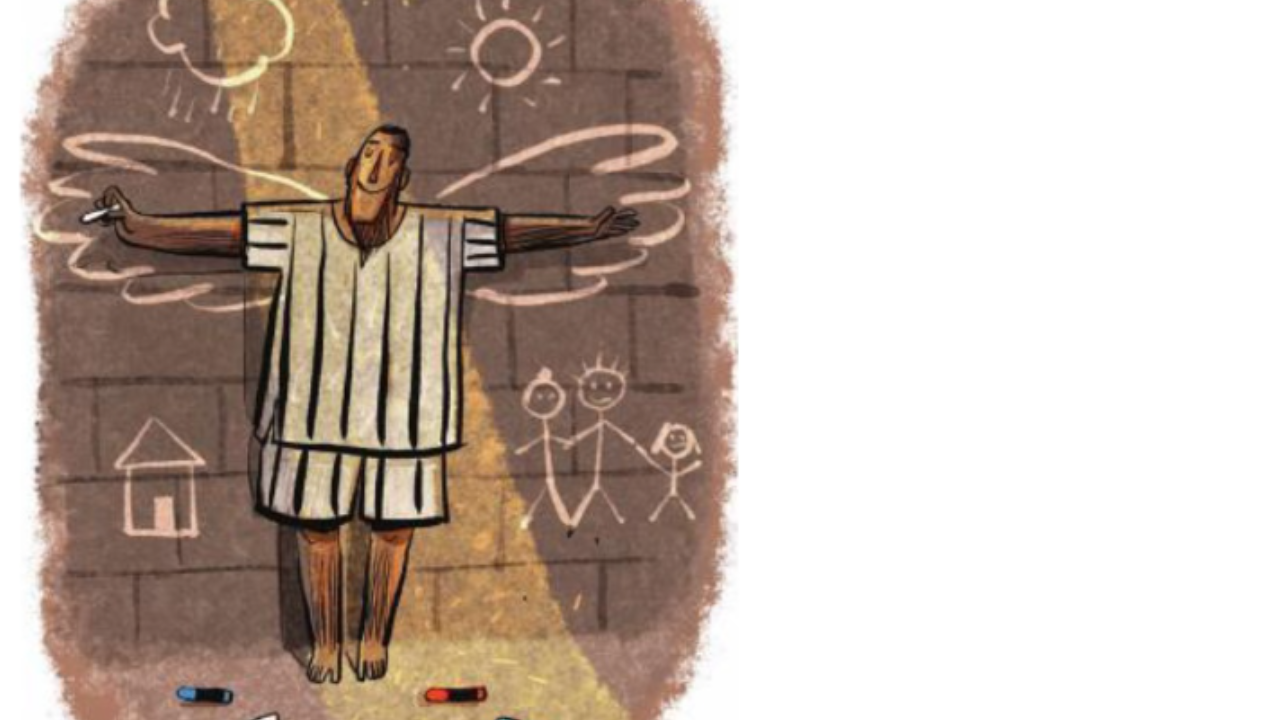India
In Ahmedabad jail, the art of peering inside | India News

[ad_1]
Babu Parmar (name changed), 40, convicted in a murder case, has been behind bars for the past four years. Introverted and not accustomed to the idea of traditional counselling, he participated in a self-expression assessment session, albeit reluctantly, where he was asked to draw anything he wanted on a piece of paper. The session was conducted periodically by experts to assess his mental health.
Parmar’s earlier sketches were darker — the human figures had their eyes closed, hands underdeveloped or behind their backs. His scenery drawings would often reflect what he observed in Ahmedabad Central Jail, including bars, barracks or policemen. However, two months into the exercise, his creations became more refined — the human figures now had arms stretched out and, occasionally, Parmar would include the sun, birds or plants in his freehand drawings.
The progress was stark; the exercise turned out to be a channel for him to release his emotions. He was getting more expressive through his art, which according to experts, reflected guilt, remorse and worry about the future of his loved ones. From being a reticent inmate who hardly communicated with anyone, Parmar began interacting with other prisoners and gradually became ready to pour his heart out to the counsellors.
These sessions are part of the drawing-based psychological assessment and psychological therapies initiated by a team from the School of Criminology and Behavioural Sciences (SCBS) of Rashtriya Raksha University (RRU).
‘Among first such experiments with prisoners’
The initiative, which began in collaboration with Gujarat State Legal Services Authority, RRU and the Gujarat prison department, was inaugurated by former Chief Justice of India UU Lalit in August 2022.
Dr SL Vaya, chief mentor at SCBS and one of the pioneers of forensic psychology in India, said this is one of the first such experiments with prison inmates who usually do not open up or express their feelings.
“The criminal justice system often sees the inmate as a person who needs to be punished for his deed. The stigma attached creates hindrances for their seamless assimilation into society once their prison term is over. They often lapse into recidivism as the underlying mental health issues are not addressed,” she said. “Drawing-based assessment is a part of the larger objective of ensuring overall mental well-being of the inmates which includes teaching them breathing techniques such as anapanasati and engaging them in group activities. Assessment forms the base of the subsequent therapy if needed. ”1,300 Sessions In Almost A Year At present, a team of nine experts, including criminologists, forensic psychologists and clinical psychologists, is associated with the project. Since August 2022, the team has conducted over 1,300 sessions covering 3,000 inmates. Limited to convicts earlier, the programme has now been extended to undertrial prisoners, too. The team works with the inmates for about 15 hours a week on average.
Dr Mahesh Tripathi, associate professor (clinical psychology) at SCBS, said positive feedback from inmates has encouraged many others to join the programme.
Based on the assessment of their drawings, the experts identify issues ranging from pentup anger or guilt to anxiety or desperation. The quality of the drawing is also indicative of the person’s psychological state. Those who are not in the right frame of mind often create shaky drawings or make several changes to what they have drawn.
“As it’s a sustained initiative, it helps us assess a person over a longer period of time. The method doesn’t need words. We realised that those who have been in prison for a long time do not draw natural scenes. We don’t see the sun, rivers or trees etc, in their drawings. Their human figures are also ‘closed’, with their eyes and mouth shut and hands held very close to the body either behind their backs or in the front,” he said.
The initiative has helped the assessors identify suicidal or self-harm tendencies, depression and sudden mood changes among the inmates. According to the experts, a series of images works as a pictogram of emotions, like an ECG for the heart, paving the way for conventional counselling and psychotherapy sessions, they added.
‘A flower indicates hope’
Explaining the symbolism in the prisoners’ drawings, Tripathi said, “Drawing a flower motif, for example, indicates hope. Those who are about to leave the prison or who have just come back after a furlough or bail often depict typical natural scenery, their wife, children and self, or the food they like or the places they visit or religious iconography. ”
Vaya added that such drawings give a deeper insight into the person’s mind without needing to prod them for details or them to have the language skills to be articulate.
“Each such session, held under the watchful eyes of the experts trained in the method, results in the interpretation of symbols, motifs and factors such as darker or lighter shade, stable and confident lines or shaky and unsure strokes. The diagnostic assessment then becomes the basis of intervention either by the prison administration or the counsellor,” she said. “We are in the process of standardising the tools so that they can also be used by other facilities,” she added.
Parmar’s earlier sketches were darker — the human figures had their eyes closed, hands underdeveloped or behind their backs. His scenery drawings would often reflect what he observed in Ahmedabad Central Jail, including bars, barracks or policemen. However, two months into the exercise, his creations became more refined — the human figures now had arms stretched out and, occasionally, Parmar would include the sun, birds or plants in his freehand drawings.
The progress was stark; the exercise turned out to be a channel for him to release his emotions. He was getting more expressive through his art, which according to experts, reflected guilt, remorse and worry about the future of his loved ones. From being a reticent inmate who hardly communicated with anyone, Parmar began interacting with other prisoners and gradually became ready to pour his heart out to the counsellors.
These sessions are part of the drawing-based psychological assessment and psychological therapies initiated by a team from the School of Criminology and Behavioural Sciences (SCBS) of Rashtriya Raksha University (RRU).
‘Among first such experiments with prisoners’
The initiative, which began in collaboration with Gujarat State Legal Services Authority, RRU and the Gujarat prison department, was inaugurated by former Chief Justice of India UU Lalit in August 2022.
Dr SL Vaya, chief mentor at SCBS and one of the pioneers of forensic psychology in India, said this is one of the first such experiments with prison inmates who usually do not open up or express their feelings.
“The criminal justice system often sees the inmate as a person who needs to be punished for his deed. The stigma attached creates hindrances for their seamless assimilation into society once their prison term is over. They often lapse into recidivism as the underlying mental health issues are not addressed,” she said. “Drawing-based assessment is a part of the larger objective of ensuring overall mental well-being of the inmates which includes teaching them breathing techniques such as anapanasati and engaging them in group activities. Assessment forms the base of the subsequent therapy if needed. ”1,300 Sessions In Almost A Year At present, a team of nine experts, including criminologists, forensic psychologists and clinical psychologists, is associated with the project. Since August 2022, the team has conducted over 1,300 sessions covering 3,000 inmates. Limited to convicts earlier, the programme has now been extended to undertrial prisoners, too. The team works with the inmates for about 15 hours a week on average.
Dr Mahesh Tripathi, associate professor (clinical psychology) at SCBS, said positive feedback from inmates has encouraged many others to join the programme.
Based on the assessment of their drawings, the experts identify issues ranging from pentup anger or guilt to anxiety or desperation. The quality of the drawing is also indicative of the person’s psychological state. Those who are not in the right frame of mind often create shaky drawings or make several changes to what they have drawn.
“As it’s a sustained initiative, it helps us assess a person over a longer period of time. The method doesn’t need words. We realised that those who have been in prison for a long time do not draw natural scenes. We don’t see the sun, rivers or trees etc, in their drawings. Their human figures are also ‘closed’, with their eyes and mouth shut and hands held very close to the body either behind their backs or in the front,” he said.
The initiative has helped the assessors identify suicidal or self-harm tendencies, depression and sudden mood changes among the inmates. According to the experts, a series of images works as a pictogram of emotions, like an ECG for the heart, paving the way for conventional counselling and psychotherapy sessions, they added.
‘A flower indicates hope’
Explaining the symbolism in the prisoners’ drawings, Tripathi said, “Drawing a flower motif, for example, indicates hope. Those who are about to leave the prison or who have just come back after a furlough or bail often depict typical natural scenery, their wife, children and self, or the food they like or the places they visit or religious iconography. ”
Vaya added that such drawings give a deeper insight into the person’s mind without needing to prod them for details or them to have the language skills to be articulate.
“Each such session, held under the watchful eyes of the experts trained in the method, results in the interpretation of symbols, motifs and factors such as darker or lighter shade, stable and confident lines or shaky and unsure strokes. The diagnostic assessment then becomes the basis of intervention either by the prison administration or the counsellor,” she said. “We are in the process of standardising the tools so that they can also be used by other facilities,” she added.
#Ahmedabad #jail #art #peering #India #News





